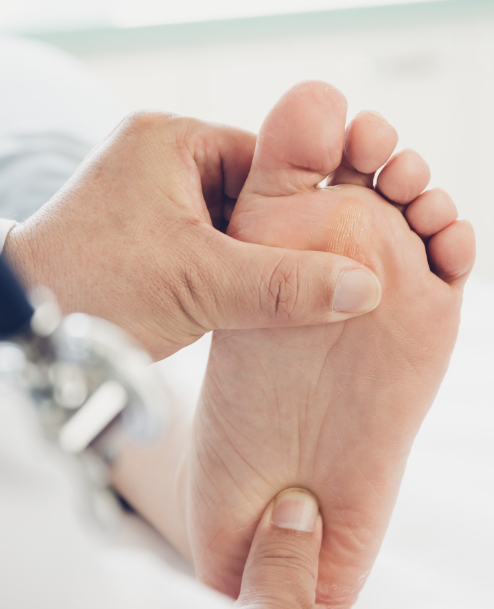Foot Related Conditions
Sweaty or Foul Smelling Feet
Most of us have suffered from foot perspiration and odour from time to time. Yet, for some people, sweaty feet (hyperhidrosis) and foul foot odour (bromhidrosis) are persistent problems that can be embarrassing and uncomfortable. With 250,000 sweat glands, feet tend to sweat more than other parts of the body, but most of us can keep sweaty feet in check with a daily hygiene routine.
hy•per•hi•dro•sis
excessive perspiration
brom•hi•dro•sis
excessive foul odour
Why Do Feet Sweat?
Our skin has many functions. Among them is getting rid of excess heat from our body. This is accomplished by evaporative cooling. When there is excess sweating, or it remains on the body, the sweat accumulates, it is called hyperhidrosis.
What’s That Smell?
Sweat ordinarily does not produce an odour. If the sweat stays on the skin too long, it can contribute to the growth of bacteria. Bromhidrosis is the accumulation of the bacteria, fungi, mould and yeast on the foot, especially between the toes.
Possible Causes
- Stress on the foot due to a structural problem, strained or tired
- Hot weather can make matters worse
- Inherited conditions.
- In adolescents: overactive sweat glands triggered by changing hormonal levels in the body
What are the risks of sweaty feet?
Sweaty feet can harm other aspects of your foot health.
- Shoe Breakdown: Excess sweat can cause the breakdown of your shoes in spots that could cause rashes and lead to a more rapid deterioration of your shoes.
- Bacteria Growth: Shoes are now dark and damp – the perfect environment for bacteria, including nail and skin fungus and viral skin infections.

What can I do?
The best way to prevent bromhidrosis (stinky feet) is to have proper foot hygiene. If the feet, toes and toe webs are not well cleaned regularly and kept dry, sweat will accumulate, and foot odour and infections can result.
- Use a surgical-grade antibacterial soap such as Betadine® Skin Cleanser, Phisoderm® or Hibiclens® (or generic equivalents) available at your pharmacy. Deodorant soaps are not enough to control bacteria.
- Clean with a washcloth and then lather up the feet again with one of the antiseptic soaps and allowing that lather to sit on the feet for a minute before washing it off.
- It is crucial to dry the feet and toe webs thoroughly.
Learn about Clean Sweep™, an antimicrobial shoe shield that eliminates 99.9% of odour-causing bacteria and fungus on contact. For your convenience, Clean Sweep™ is available at the Werkman Foot & Orthotic Clinic in Oakville.
Are my shoes and socks the problem?
We usually encase our feet in closed, tight shoes, often made of non-absorbent materials, such as patent leather, plastics, vinyl, and rubber. Frequently shoes are glued together. We wear socks made of sweat-retaining materials. Working in a hot environment or participating in vigorous activities will naturally make your feet sweat more. Where there is sweat, there’s the opportunity for odour.
- Wear shoes that fit correctly and allow plenty of room in the toe box. If you can not easily wiggle your toes in the shoes, they’re too tight.
- Wear shoes with uppers made of leather, not synthetic materials.
- Never wear the same shoes two days in a row. Rotate through them.
- Use shoe trees, and allow your shoes to dry out a full day before wearing that pair again.
- Powder your feet, toes and webs (not the shoes) with a good foot powder such as ZeaSorb® (which contains micro-fine cellulose) before putting on your socks or stockings.
- A thin pair of polypropylene socks (AKA “polypro,” e.g. LIFA®) worn under more absorbent socks of the acrylic-wool blend will keep the feet drier. A medium-bulk acrylic sock would be a good substitute for the preceding combination.
- Avoid all-cotton socks: they are absorbent, but they hold the sweat against the skin.
- Wear clean, white socks daily. Some dyes react with bacteria and make things worse.
- If needed, change your socks or stockings halfway through the day, re-powdering when you do. Charcoal insoles will also help to absorb some of the sweat.
- Wear sandals or flip-flops around the house and, where appropriate, go shoeless with or without a pair of fresh, clean socks. Avoid foam-filled or terry cloth slippers.
What else can be done?
Several other tools and techniques can help to lessen the problem of sweaty and smelly feet.
- Soaking your feet in black tea daily can be helpful. Black tea contains astringent tannic acid, which has antiperspirant properties but may stain your skin.
- For severe sweating and cracking between the toes, place a wick of gauze in each web space, extending onto the top and bottom of the feet. These can be cut from a cotton gauze pad or a roll of soft-woven gauze.
Contact us to book an appointment and to get more information on treatments for sweaty or smelly feet!
Articles of Interest
Sweaty & Foul-Smelling Feet
Most of us have suffered from sweaty feet and .....
Struggling with Sweaty, Stinky Feet?
Many people struggle with bromhidrosis and hyperhidrosis. Big words, .....
Keep Your Feet on the Ground…and Keep Them Healthy!
Feet are designed to carry us to the places we .....

